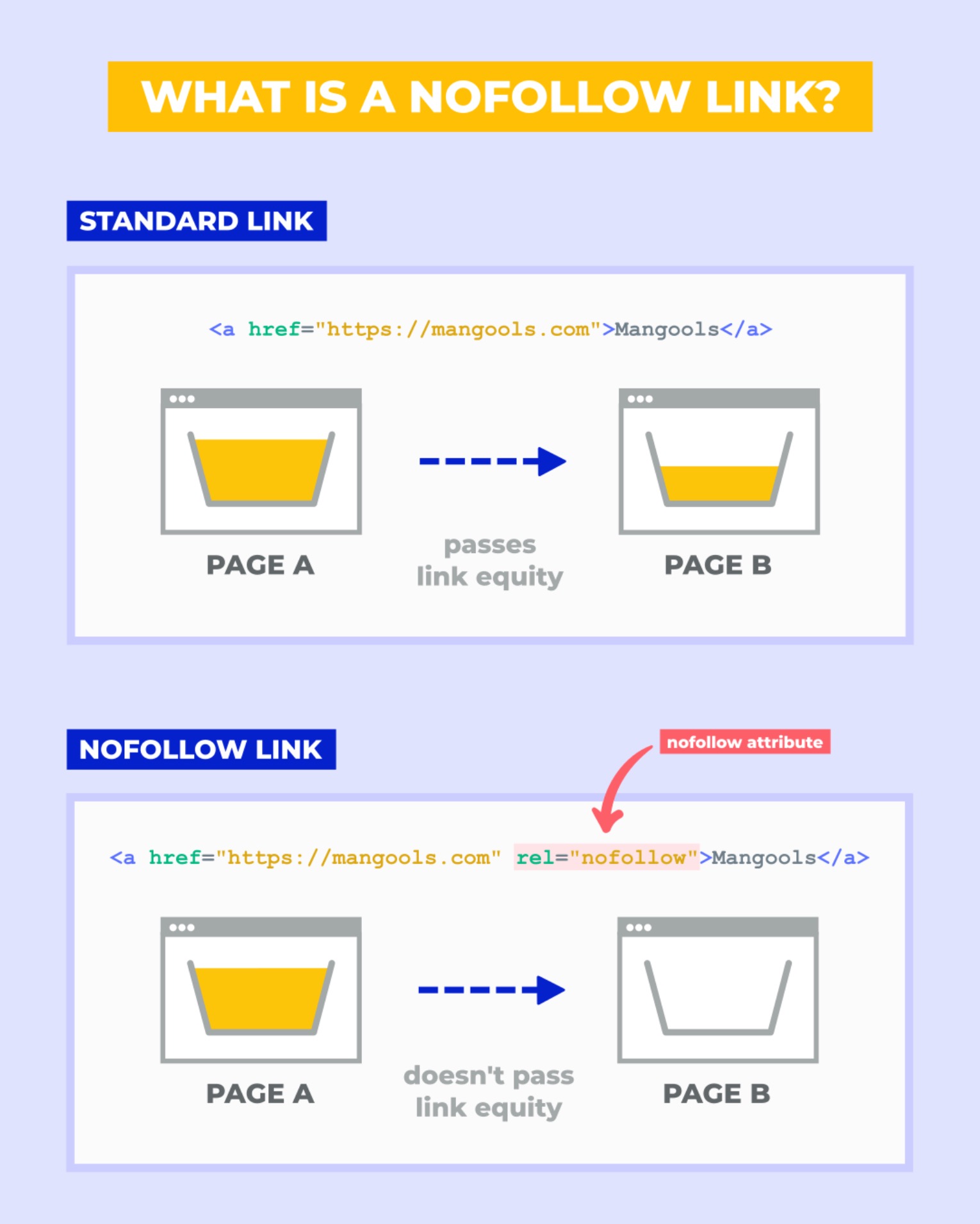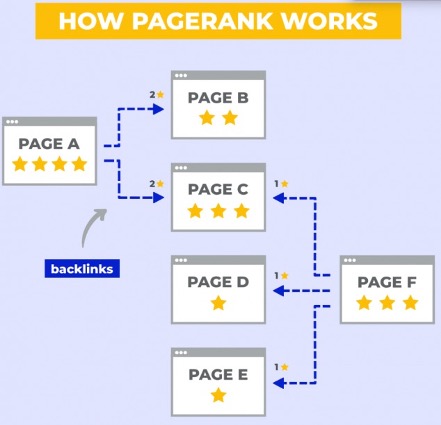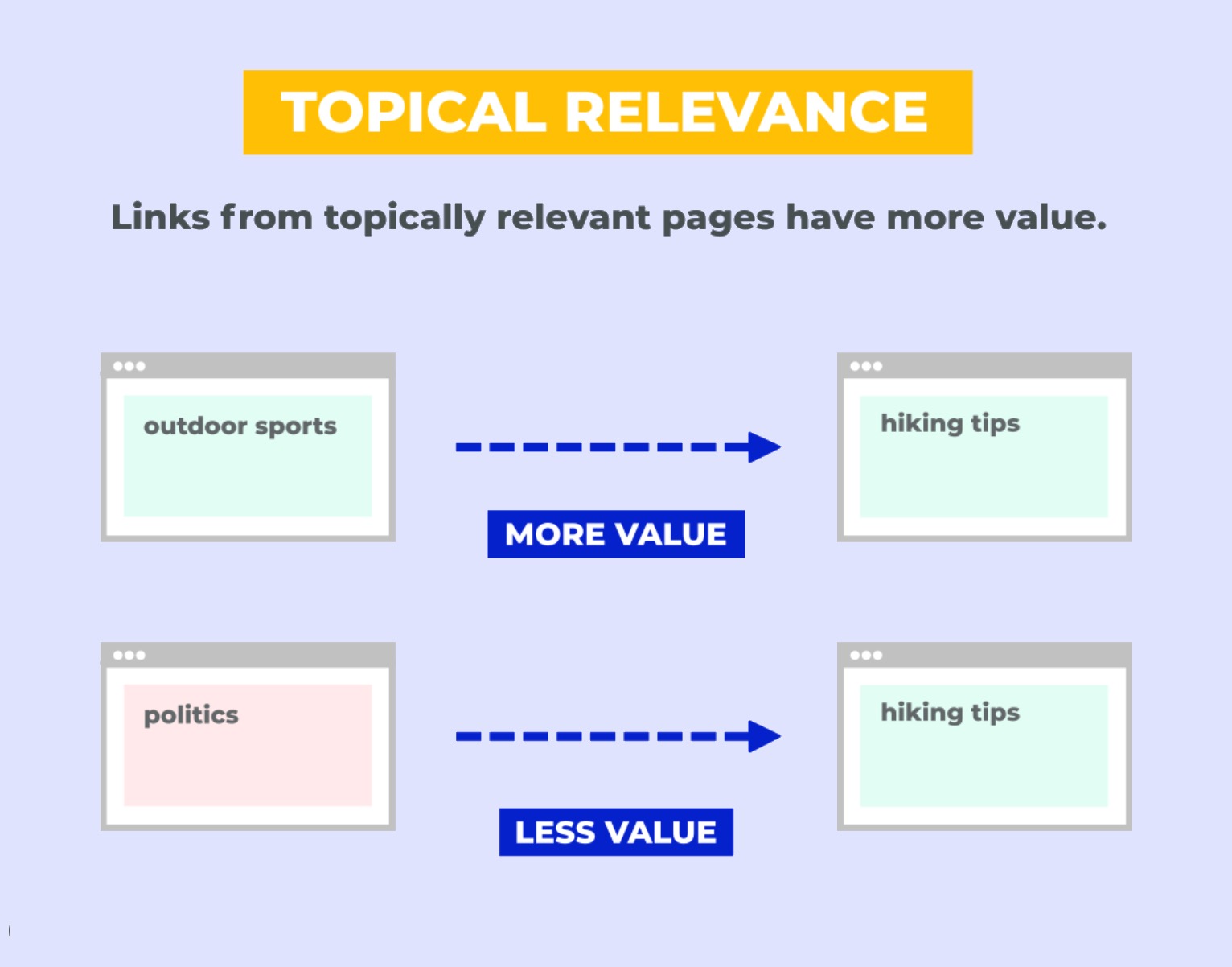Search Engine Optimization
#10 Link building and establishing authority
Link building and establishing authority
Your website needs to create trust
You must establish authority for your site to surpass the competition and boost your website’s ranking. One way to achieve this is by earning links from reputable websites, building your brand, and cultivating a following that will help promote your content. According to Google, links and quality content are two of the three most critical ranking factors for SEO.
Trustworthy websites link to other reliable websites, while spammy sites link to other spammy sites. As a result, gaining links from trustworthy sites can help improve your website’s authority and overall search engine ranking.

Domain authority
Domain authority a quantitative measure that refers to a website’s authority. The metric facilitates the assessment of the performance of a website relative to each other. It is also a good indicator of how the company in question has worked with SEO. The higher the value between 0-100, the better the authority.
The system with domain authority was created as a tool to be able to predict how high a website can rank on Google. The algorithm of the system is similar to how Google ranks a website.
Domain authority and page authority are similar, the only difference is that page authority refers to a specific page on the website.
Types of links
Links can be classified into various categories. Here are the most basic ones you should know:
Internal links
Internal links refer to links that direct a user from one page to another within the same website. These types of links, which connect pages within the same domain, function similarly for your website. If a particular page on your site has many internal links, this signals to Google that the page is significant.
Inbound links
Inbound links, or external links, are HTML hyperlinks that direct users from one website to another. Backlinks have played a significant role in search engine algorithms since their inception, working similarly to academic citations. Search engine developers recognize that the page is valuable and trustworthy if numerous reputable resources link to a specific page.
No follow links
Place JavaScript files at the end of the body or use the ‘async’ attribute to load them asynchronously.
A no follow link is a link that contains a rel=”nofollow” attribute in its HTML code.
It was introduced in 2005 by Google, and it tells search engines not to pass link equity to the linked page. The instances when the no-follow attribute can be used include:
-
- Links in comments. It helps to fight comment spam as it makes links in comments less valuable.
- Affiliate and sponsored links. With the no-follow attribute, you won’t violate Google’s rules about buying backlinks.
- Links to websites you don’t want to endorse. Sometimes you need to link to pages you don’t want to endorse.
Anchor text
The anchor text refers to the visible and clickable portion of a hyperlink that helps search engine crawlers understand the linked page’s content.
There are various types of anchor texts, including:
- Brand name: The anchor text consists of your brand name.
- Phrase match: The anchor text includes the keyword phrase you want to rank for.
- Exact match: The anchor text is the same keyword or phrase for which you want to rank.
- Partial match: The anchor text includes all the words in the search but not as an exact phrase.
- Naked URL: The anchor text is the unformatted URL as it appears in a browser.
- Random: The anchor text is a generic phrase that does not include your target keyword (e.g., “click here,” “this site,” “this article,” and so on.)
- Image links: The anchor text is the image’s alt text, according to Google.

If more pages link to you with relevant terms used in the anchor texts, it may help you rank for these terms in the search engines. This doesn’t mean you should try to get keyword-stuffed anchor texts at any cost.
Google page rank
Three factors influence the PageRank of a page:
- The number of backlinks: The more backlinks a page has, the better its PageRank will be.
- The number of links on the linking page: The value, also known as link equity, is shared among all the linked pages.
- The PageRank of the linking page: A backlink from a page with a higher PageRank will pass more link equity.
Attributes of a valuable backlink
Not all backlinks are created equal. Besides the obvious differences between internal and external links and standard vs. no-follow links, two backlinks may have different values and pass different amounts of link equity, based on many other factors.
Topical relevance
A valuable backlink is topically relevant. It means the linking page should be about the same or similar topic as the linked page.
From an authorative website
Pages with quality links pointing to them also pass more link equity to your page.
The more authoritative is the linking page, the more value the backlink has for you.
There is no official metric by Google that would represent the authority of a page but there are many metrics by commercial tools that can help you with the estimation.
Website uniqueness
The uniqueness of a backlink can be discussed on three levels.


Website level
Getting a backlink from a website that has not linked to your site before generally holds more value than one from a site that has previously linked to you. Having ten backlinks from 10 distinct websites is more advantageous than having 50 backlinks from the same website.
Page level
If you have two links from the same page, the one that appears first may have more value than the second one.
Number of other links
The PageRank is divided equally among all the linked pages. Therefore, there is a significant distinction between a backlink from a page that links to only three resources and a backlink from a page that links to 30 resources.
Placed near the top in the body
A link of high quality can drive traffic to your website. This is important not just for the obvious reasons of gaining new visitors but also from an SEO perspective.
The more prominently a backlink is positioned, the more significance it holds for Google. In simpler words, a backlink at the top of an article carries more weight than the bottom. Furthermore, a backlink at the bottom of the report holds more value than one in the footer or sidebar.
Relevant anchor text
Anchor text is a crucial aspect of link building, as backlinks with relevant anchor text are considered more valuable than those with generic or irrelevant anchor text. It’s also important to consider the surrounding text of the link, as it can carry contextual information.
Should you do link building?
While creating great content is crucial, earning quality backlinks is more complicated than that. It can be challenging for new websites to get quality backlinks without additional effort. Additionally, it isn’t easy to rank without any backlinks, especially for new sites.
Thus, link-building is a significant aspect of SEO. Fortunately, various techniques can assist in obtaining backlinks while still offering value to users. However, being cautious and avoiding black hat SEO measures is essential.

Your link profile
Your site’s link profile is a comprehensive evaluation of all the incoming links your site has received, including their number, quality, and variety. Does one site have numerous links pointing to your site, or does your site have one link from many different sites? Additionally, several other criteria are considered.
The condition of your link profile helps search engines comprehend the relationship between your site and other sites on the web. Numerous SEO tools are available to assist you in analyzing your link profile and gaining a general understanding of its composition.
What are the qualities of a healthy link profile?
In the past, people realized the potential of links and started manipulating them to boost their search engine rankings. These black hat tactics may provide short-term benefits but are against Google’s terms of service and can result in a website being removed from search results.
Maintaining a healthy link profile that demonstrates to search engines that you are earning your links and authority ethically is crucial. To avoid lying, cheating, or stealing, you should aim for an honest link profile made through hard work. Various SEO techniques can help you earn backlinks without resorting to unethical practices.
Links are earned or editorially placed
Editorial links are naturally added to a website or page because they want to link to your site.
To acquire earned links, the key is to create high-quality content that people genuinely find valuable and want to reference. By providing the most comprehensive and exciting resource on the web, people will naturally link to it.
Naturally, earned links don’t require any specific action from you except for the creation of quality content and the ability to raise awareness about it.
Links are relevant and from topically similar websites
Links from websites within the same topic-specific community as your site are typically more beneficial than links from unrelated websites. In contrast, links from topically irrelevant sources can confuse search engines about your page’s central theme.
Anchor text is descriptive and relevant, without being spammy
The anchor text used in links can indicate what the linked page is about to search engines. If a page has numerous links with similar anchor text, it is more likely to rank well for those specific phrases. However, it’s essential to be cautious of using too many identical anchor texts, as this may be viewed as an attempt to manipulate search rankings.
Using descriptive anchor text that accurately describes the linked page’s content can aid search engines in understanding the page’s topic. However, using the same description repeatedly from various sources can be seen as suspicious. It’s best to focus on relevance and avoid any potential spam.
Links send qualified traffic to your site
The primary goal of link building should include more than just improving search engine rankings. Instead, the focus should be on obtaining links to generate high-quality website traffic. Therefore, it’s crucial to prioritize acquiring links from websites relevant to your niche, with an audience likely to benefit from your site’s content.
Link building don’ts & things to avoid
The link profiles that are considered spammy are those that contain links built through unnatural, sneaky, or low-quality methods. Even though buying links or exchanging links is an easy option, it is risky and can endanger all of your hard work. It is important to remember that Google penalizes websites with spammy link profiles.
Your link-building strategy should always abide by the principle of not attempting to manipulate a site’s ranking in search results. Google prefers that links be earned rather than built. However, distinguishing between the two can take time and effort. Google has explicitly outlined what should be avoided to prevent penalties for unnatural links.
Purchased links
Google’s goal is to reduce the impact of paid links on organic search results. Although it’s difficult for a search engine to differentiate between earned and paid links based on the link alone, specific patterns can indicate foul play, which Google uses to detect them. Websites caught engaging in paid link schemes face significant penalties, such as a severe drop in search rankings.
Link exchanges / reciprocal linking
The link exchange practice involves soliciting links from unrelated websites in return for linking to them. Google’s quality guidelines warn against excessive link exchange and other programs solely for cross-linking. While small-scale link exchange may not trigger spam detection, it is generally not recommended.
On the other hand, linking to partners, collaborators, or other affiliated websites, and having them link back to you, is acceptable and can be beneficial. However, engaging in mass link exchange with unaffiliated sites can lead to penalties.

Low quality directory links
These directories were previously a favored means of manipulation. Many pay-for-placement web directories now cater to this market and try to present themselves as legitimate, with varying degrees of success. These websites often appear very similar, with extensive lists of websites and their descriptions.
How to build high-quality backlinks
Link-building can take on various forms and approaches, yet it is crucial that your link-building strategies align with your specific objectives. Nonetheless, certain widely utilized tactics typically yield positive results across different campaigns.
Find customer and partner links
It is possible to obtain links from your partners or loyal customers who positively perceive your brand. Several methods can be used to earn these links effortlessly. For instance, you may distribute partnership badges, graphic icons demonstrating mutual respect, or product testimonials. These options give them something to exhibit on their website, including links that direct back to your site.
Publishing a blog
Creating content and building links through blogs is highly recommended by Google’s engineers as it is considered valuable. Blogs can provide fresh content regularly, spark discussions across the web, and attract listings and links from other blogs.
However, avoiding engaging in low-quality guest posting is essential to obtain links. Google has discouraged this practice, and your efforts are better directed elsewhere.

Create unique resources
Producing top-notch, original content is challenging, but it can yield significant benefits. High-quality content can be widely shared and attract numerous links when executed correctly. Here are some characteristics that can make a piece of content stand out:
- Elicits powerful emotions
- Presents a novel perspective or conveys information in an innovative manner
- Visually appealing
- Addresses a current need or interest
- Location-specific
Developing such a resource can be an excellent way to acquire many links within one page. Alternatively, you could create a particular resource aimed at a few websites. This approach may lead to a higher success rate but could be more scalable.
When people encounter unique content, they often want to share it with others. Bloggers and webmasters proficient in technology and content creation may link to it. These editorially earned links can significantly build trust, authority, and search engine rankings.
Refurbish top content
You should be aware of the content on your site that brings in the most traffic, conversions, or engagement. To attract visitors beyond Google’s reach, take that content and refurbish it for other platforms like SlideShare, YouTube, Instagram, Quora, and others.
Additionally, you can update and republish older content on the same platform to refresh its appeal. If you find out that some reputable websites in your industry are linked to an outdated resource, consider updating them and informing those sites about the new version, which could earn you valuable links.
You can also apply this strategy to images. If you find that some websites are using your images without crediting you or linking back to your site, contact them and request that they add a link to your site.
Be newsworthy
Getting noticed by bloggers, journalists, and the media is a proven and valuable method for building links. It can be as easy as offering a free giveaway, launching a new and impressive product, or taking a bold and controversial stance. A significant aspect of SEO involves creating an online image of your brand that matches the real-world image of your brand. To excel in SEO, it is necessary to develop a strong brand.

Outreach email
Email outreach involves contacting owners of authorative websites or influencers through email to secure backlinks, promote content, or establish partnerships. This strategy targets potential link-building individuals and presents them with a proposal. While it may seem straightforward, effective outreach requires more insight and preparation than it appears at first glance.
A common reason for the failure of many email outreach initiatives is the lack of a well-defined process that could ensure success.
Moreover, outreach often suffers from widespread misconceptions and can be unfairly labelled as spammy. This negative perception arises because many marketers must implement a rigorous process and send mass emails indiscriminately without considering the recipients’ interest in the content.
Such an approach needs to be revised.
Contrary to spam, proper email outreach is about thoughtfully identifying and connecting with those who might find your content valuable and encouraging them to engage with it if they are impressed.
However, the incorrect execution of this strategy is prevalent, leading to poor experiences for many who receive these poorly crafted outreach emails. The primary mistake made by novice SEOs using outreach emails, is missing the needs to pay attention to creating a unique, personalized, and valuable initial outreach email.
The objective of an initial outreach email is to elicit a response. Here are some suggestions:
- Personalize it by mentioning something specific about the individual, such as what they’re working on or where they went to school.
- Provide value by alerting them to a broken link on their website or a page that needs to be mobile-friendly.
- Keep it brief.
- Ask a single, straightforward question, typically not for a link. It would be best if you focused on developing a relationship first.
